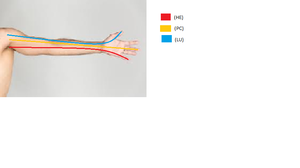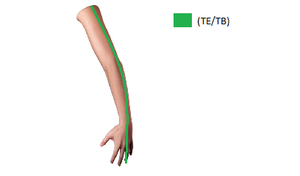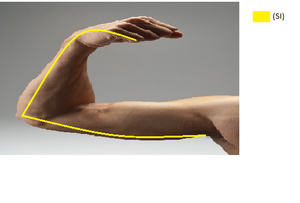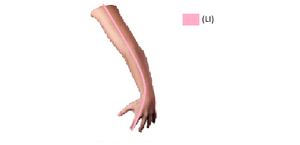Upper Limb Acupuncture Points
Meridians of the Upper Extremity[edit | edit source]
| Anterior: | Posterior: |
|---|---|
| - Pericardium Channel (PC)
- Heart (HE) - Lung (Lu) |
- Triple Energizer/Burner (TE/TB) |
| Medial: | Lateral: |
| -Small Intestine (SI) | -Large Intestine (LI) |
Table 1. Meridian channels of the upper extremity [1]
Location & Use:[edit | edit source]
Pericardium Meridian:[edit | edit source]
The pericardium channel consists of nine acupuncture points. The channel originates from the chest lateral to the nipple and travels upwards to the axillary fossa. It then descends down the anterio-medial aspect of the arm to the cubital fossa and continues between Palmaris Longus and Flexor Carpi Radialis. The channel terminates at the tip of the third digit.[1][2]
Used as an antiemetic point especially during pregnancy and post-operative pain.[1][2]
Heart Meridian:[edit | edit source]
The Heart Meridian consists of nine acupuncture points. The channel originates from the centre of the axilla and descends through the anterio-medial aspect of the arm to the pisaform region, terminating at the tip of the little finger.[1][2]
. Used for forearm/hand numbness and pain, tremors, elbow injuries and neck stiffness.[1][2]
Lung Meridian:[edit | edit source]
The Lung Meridian consists of eleven acupuncture points. The channel originates on the lateral chest and descends through the anterio-medial region of the upper arm. It crosses over to the lateral aspect of the arm at the cubital fossa and continues to the radial side of the wrist, terminating at the tip of the thumb.[1][2]
Used for elbow, shoulder and thoracic injuries.[1][2]
Used for paralysis of the fascial muscles, jaw pain and soft tissue injuries of the wrist.[1][2]
Used for forearm and wrist pain and associated local soft tissue injuries.[1][2]
Triple Energiser/Burner:[edit | edit source]
The triple energiser/triple burner consists of 23 acupuncture points. The channel originates from tip of the ring finger and ascends through the posterior aspect of the arm until it reaches the shoulder. It terminates at the outer end of the eyebrow. [1][2]
Key points:[edit | edit source]
Used for facial pain, stiffness of the neck, shoulder arthritis and arm/elbow pain.[1][2]
. Used for shoulder/arm pain, restricted range of motion and soft tissue injuries.[1][2]
Small Intestine:[edit | edit source]
This channel consists of 19 acupuncture points. It originates at the tip of the 5th digit and ascends along the ulnar border to the scapula. Here it zig zags across the scapula and terminates at the anterior aspect of the ear.[1][2]
Key points:[edit | edit source]
SI3- Proximal to the base of the 5th metacarpal bone, at the junction of the red and white skin. Used for lumbar, neck, shoulder and arm pain, headaches.[1][2]
SI8- In the depression between the medial epicondyle of the humerus and olecranon, when the elbow is flexed. Used for pain in the arm, elbow, shoulder and scapular region and cervical spine pain or restricted range of motion.[1][2]
SI9- 1 cun superior to the posterior end of the axillary fold with the arm in abduction. Used for motor function impairment of the arm, pain/injuries along the arm/shoulder or scapular region.[1][2]
SI10- With the arm still abducted, 1 cun superior to SI 9 in the depression inferior and lateral to the scapular spine, Used for motor function impairment of the arm. Pain and/or weakness of the arm. Shoulder/scapular injuries.[1][2]
SI11- one-third the distance between the inferior angle of the scapula and the lower border of the scapular spine, in the depression of the infrascapular fossa, Used for pain in the elbow, shoulder and/or scapular region.[1][2]
Large Intestine:[edit | edit source]
This Meridian consists of 20 acupuncture points. It originates at the tip of the 2nd digit and ascends along the lateral aspect of the arm to the tip of the shoulder. It continues travelling upwards to terminate at the opposite side of the face.[1][2]
Key points:[edit | edit source]
LI4- On the dorsum aspect of the hand, in the belly of the first Interosseus dorsalis muscle, at the midpoint of the second metacarpal bone. Used during difficult labour, arm pain, headaches and facial paralysis.[1][2]
LI11- On the lateral aspect of the cubital crease at near end range elbow flexion. Used for pain or paralysis of the arm, pain or shoulder arthritis and following elbow injuries.[1][2]
LI14- On the inferior border of the deltoid, on the line connecting LI11 and LI15. Used for shoulder/arm pain.[1][2]
LI15- Anterior and inferior to the acromion when the arm is abducted. Used for motor function impairment of the upper limb, shoulder pain and soft tissue injuries.[1][2]
Evidence-Based Practice[edit | edit source]
Frozen Shoulder:[edit | edit source]
Although there is limited evidence on traditional acupuncture and frozen shoulder, the evidence available suggests that acupuncture or electroacupuncture, in combination with physiotherapy or alone or , may be effective for improving function and joint range of motion and reducing pain in patients with frozen shoulder/adhesive capsulitis when compared to physiotherapy alone.[3]
The average number of treatments consisted of 4-10 sessions over 4-7 weeks. Duration of treatments varied between 15-30 minutes.[3]
Lateral Epicondylalgia:[edit | edit source]
Low to moderate quality of evidence suggests traditional acupuncture provides short term reductions in pain and improvements in function and strength, compared to sham/placebo and ultrasound.[3]
The average number of treatments consisted of 10 sessions over 2-6 weeks. Duration of treatments varied between 20-30 minutes.[3]
Carpal Tunnel Syndrome:[edit | edit source]
In patients with mild to moderate Carpal Tunnel Syndrome, short term acupuncture treatment over four weeks was reported as effective as short-term low dose steroid. Therefore, it was concluded as an safe alternate choice of treatment for patients who are unable to tolerate oral steroid medications.[4]
Post-operative nausea and vomiting[edit | edit source]
Stimulation of wrist acupuncture, pericardium 6 (PC6) is likely to be beneficial for patients with a high base-line risk of post surgical nausea and vomiting. [5]
Shoulder Impingement Syndrome (SIS)[edit | edit source]
Exercise combined with exercise based therapies such as acupuncture is recommended as a safe treatment method in patients with early SIS.[6]
References[edit | edit source]
- ↑ 1.00 1.01 1.02 1.03 1.04 1.05 1.06 1.07 1.08 1.09 1.10 1.11 1.12 1.13 1.14 1.15 1.16 1.17 1.18 1.19 1.20 1.21 1.22 1.23 Macdonald A. Acupuncture Main Channels or Meridians: Visible Surfaces. Int J Complement Alt Med 2017;7:00233.
- ↑ 2.00 2.01 2.02 2.03 2.04 2.05 2.06 2.07 2.08 2.09 2.10 2.11 2.12 2.13 2.14 2.15 2.16 2.17 2.18 2.19 2.20 2.21 2.22 The Chiropractic Resource Organization. Atlas of Acupuncture Points [Internet]. Pottstown, PA: Acupuncture Products.com; 2007. Available from https://chiro.org/acupuncture/ABSTRACTS/FILES/Acupuncture_Points.pdf
- ↑ 3.0 3.1 3.2 3.3 The International Centre for Allied Health Evidence. Effectiveness and Safety of Acupuncture Interventions for the Treatment of Musculoskeletal Conditions. Adelaide: University of South Australia;2018 [cited 2019 Sep 19]. 501p. Available from https://www.acc.co.nz/assets/research/2b0c243f75/acupuncture-musculoskeletal-conditions-review.pdf
- ↑ Yang C, Hsieh C, Wang N, Li T, Hwang K, Yu S, et al. Acupuncture in Patients With Carpal Tunnel Syndrome: A Randomized Controlled Trial, The Clinical Journal of Pain. 2009 May; 25 (4):327-333
- ↑ Lee A, Fan LT. Stimulation of the wrist acupuncture point P6 for preventing postoperative nausea and vomiting. Cochrane Database Systematic Reviews [Internet]. 2009 [cited 2020 Sep 20];(2). Available from https://pubmed.ncbi.nlm.nih.gov/doi:10.1002/14651858.CD003281.pub3
- ↑ Dong W, Goost H, Lin XB, et al. Treatments for shoulder impingement syndrome: a PRISMA systematic review and network meta-analysis. Medicine (Baltimore) [Journal on the Internet]. 2015 Mar [2016 Jan; 2020 Sep];94(10):e510.










